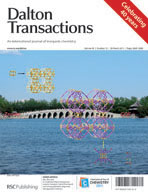The mononuclear complexes [Pt(bzq)(S⁁S)] [S⁁S = pyrrolidinedithiocarbamate (pdtc 1), dimethyldithiocarbamate (dmdtc 2)] were prepared by reaction of [Pt(bzq)(NCMe)2]ClO4 with an equimolecular amount of [NH4(pdtc)] and [Na(dmdtc)·2H2O] respectively in MeOH. Reactions of 1 and 2 with AgClO4 in 1 : 1 and 2 : 1 molar ratios rendered the heteropolinuclear compounds [{Pt(bzq)(S⁁S)Ag}2](ClO4)2 (S⁁S = pdtc 3, dmdtc 4) and [{Pt(bzq)(S⁁S)}2Ag](ClO4) (S⁁S = pdtc 5, dmdtc 6) respectively. The X-ray studies on single crystals of 3 and 4 showed that both consist of tetranuclear [Pt2Ag2] clusters with the Pt–Ag and the Ag–Ag distances in the range of those corresponding to Pt–Ag dative bonds and argentophilic interactions. In 3 the tetranuclear [Pt2Ag2] clusters are connected into infinite polymeric chains by Pt⋯Pt metallophilic interactions (Pt⋯Pt = 3.1890(7) Å). The X-ray study on a single crystal of 5 showed that it is a polymer based on trinuclear [Pt2Ag] clusters containing two unsupported Pt–Ag dative bonds and connected by Ag–S bonds in such a way that the “Pt–Ag–S–Pt–Ag–S” atoms draw a zigzag polymeric chain. TD-DFT calculations carried out for 1 indicate that the lowest energy absorption band in CH2Cl2 can be described as a mixture of 1MLCT, 1IL and 1L′LCT transitions. Powdered samples of 1 at 298 K and 77 K show a green-yellow emission band coming mainly from a 3LC excited state. However complex 2 shows “luminescence thermochromism”: the colour of its luminescence changes from green-yellow at 77 K to orange-red at 298 K. The emission of the Pt–Ag clusters, 3–6, in the solid state, are due to excimeric 3ππ and/or 3MMLCT (dσ* → π*) low-lying excited states, indicating that the presence of silver in the clusters makes the “Pt(bzq)(S⁁S)” fragments interact to a large extent through Pt⋯Pt and/or π–π interactions. Solid 3 is a highly selective vapochromic compound towards acetonitrile although this behaviour is not fully reversible.

You have access to this article
 Please wait while we load your content...
Something went wrong. Try again?
Please wait while we load your content...
Something went wrong. Try again?


 Please wait while we load your content...
Please wait while we load your content...